Bhushan B. Nanotribology and Nanomechanics: An Introduction
Подождите немного. Документ загружается.

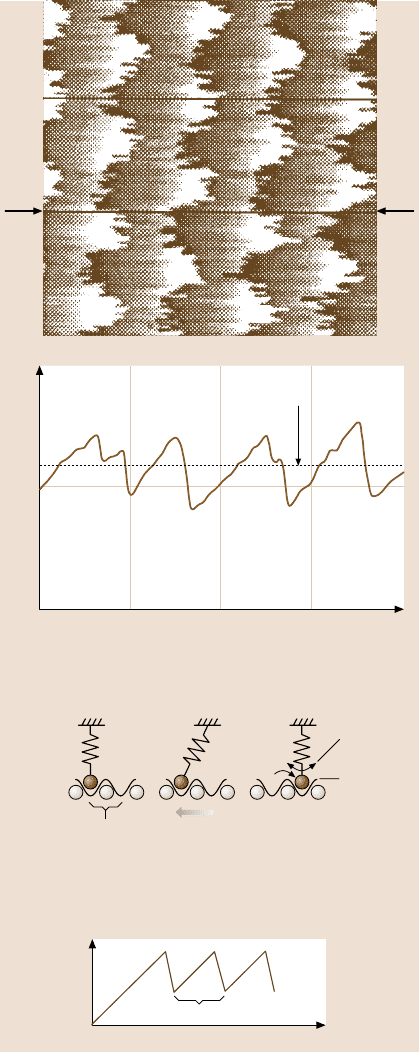
334 Bharat Bhushan
Lateral force (nN)
nm
0
1.0
0
–1.0
0.25 0.50 0.75 1.00
Average
Friction force
Distance
Sawtooth pattern of friction force arising from atomic scale
stick-slip
Sample
surface
Periodic
interaction
potential
Slip event is
a dissipative
process
Direction of motion
of sample surface
Atomic lattice
constant a
AFM tip-
cantilever
model
Equilibrium
position before
sliding begins
Stick Slip
a
b)
a)
B
B
B – B
Fig. 8.14. (a) Greyscale plot
of friction force map (raw
data)ofa1×1nm
2
area of
freshly cleaved HOPG, show-
ing atomic-scale variation of
friction force. High points
are shows by lighter color.
Also shown is a line plot of
friction force profile along
the line indicated by arrows.
The normal load was 25 nN
and the cantilever normal
stiffness was 0.4N/m [25].
(b) Schematic of a model for
a tip atom sliding on an atom-
ically flat periodic surface.
The schematic shows the tip
jumping from one potential
minimum to another, result-
ing in stick–slip behavior
8 Nanotribology, Nanomechanics and Materials Characterization 335
to a sawtooth-like pattern for the lateral motion (force) with a periodicity of the lat-
tice constant. This motion is called stick–slip movement of the tip [5, 10,22,25].
The observed friction force includes two components: conservative and periodic,
and nonconservative and constant. If the relative motion of the sample and tip were
simply that of two rigid collections of atoms, the effective force would be a conser-
vative force oscillating about zero. Slow reversible elastic deformation would also
contribute to the conservative force. The origin of the nonconservative direction-
dependent force component would be phonon generation, viscous dissipation, or
plastic deformation.
As just mentioned, stick–slip on the atomic scale is the result of the energy
barrier that must be overcome to jump over the atomic corrugations on the sample
surface. This correspondsto the energy requiredfor the jump of the tip from a stable
equilibrium position on the surface into a neighboring position. The perfect atomic
regularity of the surface guarantees the periodicity of the lateral force signal, inde-
pendentof actualatomicstructureof tipapex.Fewatoms(based onthe magnitudeof
the friction force, less than 10) on a tip sliding over an array of atoms on the sample
are expected to go through the stick–slip. For simplicity, Fig. 8.14b shows a simpli-
fied model for one atom on a tip with a one-dimensional spring–mass system. As
the sample surface slides against the AFM tip, the tip remains stuck initially until
it can overcome the energy (potential) barrier, which is illustrated by a sinusoidal
interaction potential as experienced by the tip. After some motion, there is enough
energy stored in the spring which leads to slip into the neighboring stable equilib-
rium position. During the slip and before attaining stable equilibrium, stored energy
is converted into vibrational energy of the surface atoms in the range of 10
13
Hz
(phonon generation) and decays within the range of 10
−11
s into heat. (A wave of
atoms vibrating in concert are termed a phonon.) The stick–slip phenomenon, re-
sulting from irreversible atomic jumps, can be theoretically modeled with classical
mechanical models [75,76]. The Tomanek–Zhong–Thomas model [76] is the start-
ing pointfor determiningthe friction forceduring atomic-scale stick–slip.The AFM
model describes the total potential as the sum of the potential acting on the tip due
to interaction with the sample and the elastic energy stored in the cantilever. Ther-
mally activated stick–slip behavior can explain the velocity effects on friction, to be
presented later.
Finally, based on Fig. 8.13a, the atomic-scale friction force of HOPG ex-
hibited the same periodicity as that of the corresponding topography, but the
peaks in friction and those in topography are displaced relative to each other
(Fig. 8.13b). A Fourier expansion of the interatomic potential was used by Ruan
and Bhushan [25] to calculate the conservative interatomic forces between atoms of
the FFM tip and those of the graphite surface. Maxima in the interatomic forces in
the normal and lateral directions do not occur at the same location, which explains
the observedshift between the peaks in the lateralforce and those in the correspond-
ing topography.
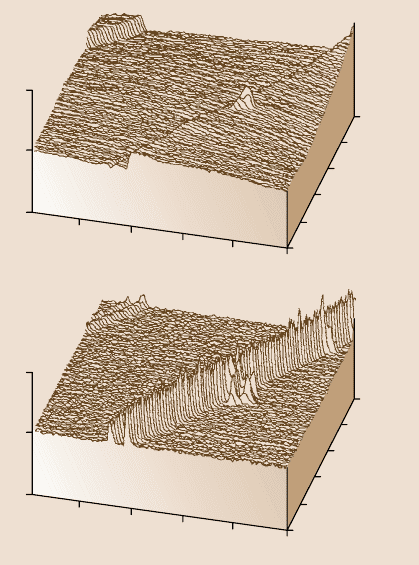
336 Bharat Bhushan
8.3.2 Microscale Friction
Local variations in the microscale friction of cleaved graphite are observed,
Fig. 8.15. These arise from structural changes that occur during the cleaving pro-
cess [26]. The cleaved HOPG surface is largely atomically smooth but exhibits
line-shaped regions in which the coefficient of friction is more than an order of
magnitude larger. Transmission electron microscopy indicates that the line-shaped
regions consist of graphite planes of different orientation, as well as of amor-
phous carbon. Differences in friction have also been observed for multiphase ce-
ramic materials [45]. Figure 8.16 shows the surface roughness and friction force
maps of Al
2
O
3
−TiC (70–30wt%). TiC grains have a Knoop hardness of about
2800kg/mm
2
and Al
2
O
3
has 2100kg/mm
2
, therefore, TiC grains do not polish as
much and result in a slightly higher elevation (about 2–3 nm higher than that of
Al
2
O
3
grains). TiC grains exhibit higher friction force than Al
2
O
3
grains. The co-
efficients of friction of TiC and Al
2
O
3
grains are 0.034 and 0.026, respectively, and
the coefficient of friction of Al
2
O
3
−TiC composite is 0.03. Local variation in fric-
tion force also arises from the scratches present on the Al
2
O
3
−TiC surface. Meyer
et al. [77] also used FFM to measure structural variations of organic mono- and
multilayer films. All of these measurements suggest that the FFM can be used for
structural mapping of the surfaces. FFM measurements can also be used to map
4
1.0 μm
0.8
0.6
0.4
0.2
0
0
–4
0
0.2
0.4
0.6
0.8
1.0 μm
Friction
force
(nN)
2
1.0 μm
0.8
0.6
0.4
0.2
0
0
–2
0
0.2
0.4
0.6
0.8
1.0 μm
Height
(nm)
Friction force
Surface height
a)
b)
Fig. 8.15. (a) Surface rough-
ness and (b) friction force
maps at a normal load of
42 nN of freshly cleaved
HOPG surface against an
Si
3
N
4
FFM tip. Friction in
the line-shaped region is over
an order of magnitude larger
than in the smooth areas [25]
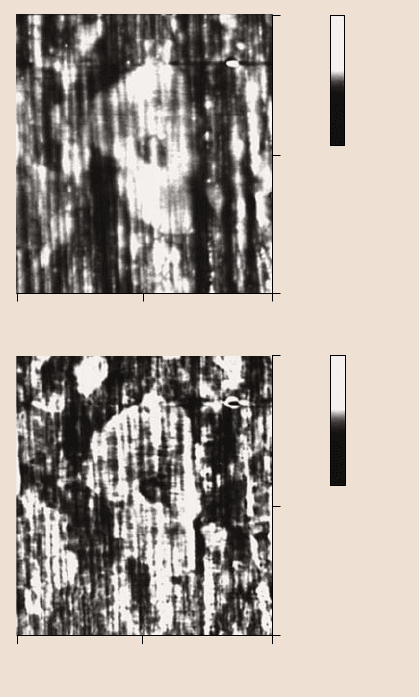
8 Nanotribology, Nanomechanics and Materials Characterization 337
5.00
2.50
0
0 2.50 5.00 μm
20.0 nm
10.0 nm
0.0nm
50 nN
25 nN
0nN
5.00
2.50
0
0
5.00 μm
2.50
Surface height
Friction force
Fig. 8.16. Greyscale surface
roughness (σ = 0.80 nm) and
friction force maps (mean =
7.0nN, σ = 0.90 nN) for
Al
2
O
3
–TiC (70–30 wt%) at
a normal load of 138 nN [45]
chemical variations, as indicated by the use of the FFM with a modified probe tip to
map the spatial arrangement of chemical functional groups in mixed organic mono-
layer films [78]. Here, sample regions that had stronger interactions with the func-
tionalized probe tip exhibited larger friction.
Local variations in the microscale friction of nominally rough, homogeneous-
material surfaces can be significant, and are seen to depend on the local surface
slope rather than the surface height distribution, Fig. 8.17. This dependence was
first reported by Bhushan and Ruan [23], Bhushan et al. [27], and Bhushan[65] and
later discussed in more detail by Koinkar and Bhushan [79] and Sundararajan and
Bhushan [80]. In order to show elegantly any correlation between local values of
friction and surface roughness, surface roughness and friction force maps of a gold-
coated rulerwith somewhatrectangulargrids anda silicon grid with squarepits were
obtained, Fig. 8.18 [80]. Figures 8.17 and 8.18 show the surface roughness map, the
slopes of the roughness map taken along the sliding direction (surface slope map)
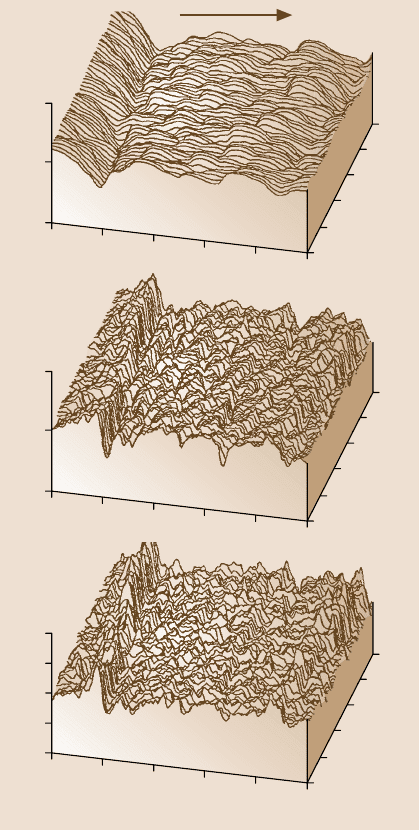
338 Bharat Bhushan
500
–0
nm
0
100
200
300
400
500 nm
20
40
nm
400
300
200
100
0
500
–0.75
nm
0
100
200
300
400
500 nm
0.00
0.75
nm
400
300
200
100
0
500
nm
0
100
200
300
400
500 nm
5
15
nN
400
300
200
100
0
10
0
–5
Surface
height
Surface
slope
Friction
force
Fig. 8.17. Surface roughness
map (σ = 4.4 nm), surface
slope map taken in the sample
sliding direction (the hori-
zontal axis; mean = 0.023,
σ = 0.197), and friction
force map (mean = 6.2nN,
σ = 2.1 nN) for a lubricated
thin-film magnetic rigid
disk for a normal load of
160 nN [27]
and the frictionforce map for varioussamples. There is a strong correlation between
the surface slopes and friction forces. For example, in Fig. 8.18, the friction force is
high locally at the edge of the grids and pits with a positive slope and is low at the
edges with a negative slope.
We now examine the mechanism of microscale friction, which may explain the
resemblance between the slope of surface roughness maps and the corresponding
frictionforce maps [4,5,11,23,25–27,79,80].There are three dominantmechanisms
of friction; adhesive, ratchet, and plowing [10,17]. At first order, we may assume
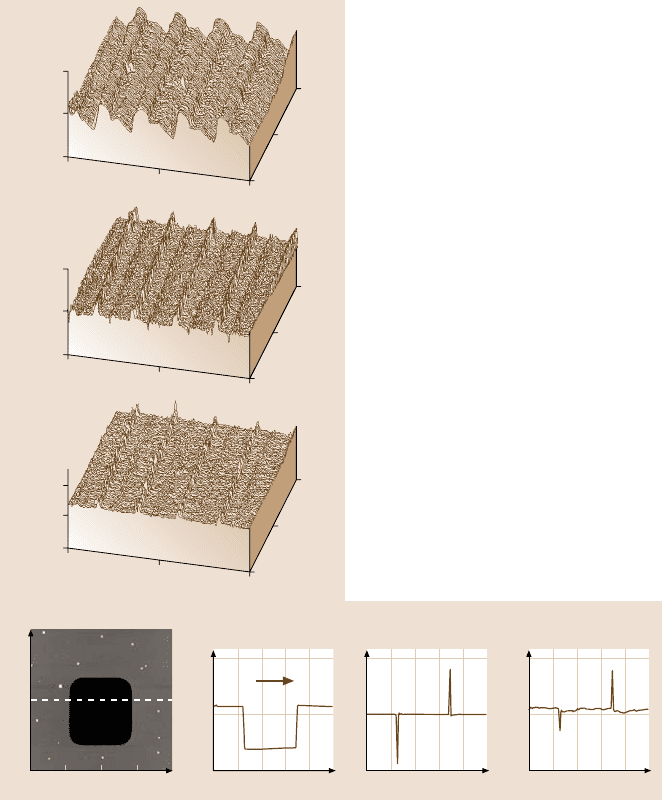
8 Nanotribology, Nanomechanics and Materials Characterization 339
0
10.0
10.0
5.0
0
5.00
0
0
2.50
5.00 μm
100
200
nm
2.50
0
5.00
0
0
2.50
5.00 μm
3.00
6.00
2.50
0
5.00
0
0
2.50
5.00 μm
0.50
1.00
V
2.50
0
μm
μm
μm
5.0
Surface height (nm)
010
250
0
–250
2
0
–2
Scan distance (μm)
0.35
0
–0.35
Surface slope Friction force (V)
010
Scan distance (μm)
010
Scan distance (μm)
High
friction
Low
friction
Surface height
Surface slope
Friction force
a)
b)
Fig. 8.18. Surface roughness map, surface slope map taken in the sample sliding direction (the
horizontal axis), and friction force map for (a) a gold-coated ruler (with somewhat rectangular
grids with a pitch of 1 µm and a ruling step height of about 70 nm) at a normal load of 25 nN
and (b) a silicon grid (with 5-µm square pits of depth 180 nm and a pitch of 10 µm) [80]
these to be additive. The adhesive mechanism cannot explain the local variation in
friction. Next we consider the ratchet mechanism. We consider a small tip sliding
over an asperity making an angle θ with the horizontal plane, Fig. 8.19. The normal
force W (normal to the general surface) applied by the tip to the sample surface
is constant. The friction force F on the sample would be a constant for a smooth
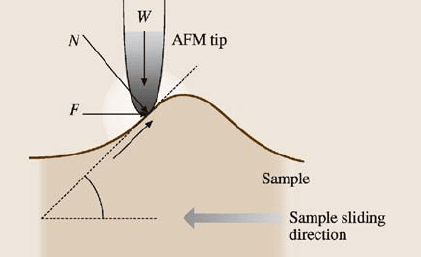
340 Bharat Bhushan
Fig. 8.19. Schematic illustration showing the effect of an asperity (making an angle θ with
the horizontal plane) on the surface in contact with the tip on local friction in the presence of
adhesive friction mechanism. W and F are the normal and friction forces, respectively, and S
and N are the force components along and perpendicular to the local surface of the sample at
the contact point, respectively
surface if the friction mechanism does not change. For a rough surface, shown in
Fig. 8.19, if the adhesive mechanism does not changeduring sliding, the local value
of the coefficient of friction remains constant,
μ
0
= S/N , (8.1)
where S is the local friction force and N is the local normal force. However, the
frictionand normalforces aremeasured withrespect toglobal horizontaland normal
axes, respectively.The measured local coefficient of friction μ
1
in the ascendingpart
is
μ
1
= F/W =
(
μ
0
+ tanθ
)
/
(
1−μ
0
tanθ
)
≈ μ
0
+ tanθ, for small μ
0
tanθ (8.2)
indicating that, in the ascending part of the asperity, one may simply add the fric-
tion force and the asperity slope to one another. Similarly, on the right-hand side
(descending part) of the asperity,
μ
2
=
(
μ
0
−tanθ
)
/
(
1+ μ
0
tanθ
)
≈ μ
0
−tanθ, for small μ
0
tanθ. (8.3)
For a symmetrical asperity, the average coefficient of friction experienced by the
FFM tip traveling across the whole asperity is
μ
ave
=
(
μ
1
+ μ
2
)
/2 = μ
0
1+ tan
2
θ
/
1−μ
2
0
tan
2
θ
≈ μ
0
1+ tan
2
θ
, for small μ
0
tanθ. (8.4)
Finally we consider the plowing component of friction with the tip sliding in either
direction, which is [10,17]
μ
p
∼ tanθ. (8.5)
8 Nanotribology, Nanomechanics and Materials Characterization 341
Because in FFM measurements we notice little damage of the sample surface, the
contribution by plowing is expected to be small and the ratchet mechanism is be-
lieved to be the dominant mechanism for the local variations in the friction force
map. With the tip sliding over the leading (ascending) edge of an asperity, the sur-
face slope is positive; it is negative during sliding over the trailing (descending)
edge of an asperity. Thus, measured friction is high at the leading edge of asper-
ities and low at the trailing edge. In addition to the slope effect, the collision of
the tip when encountering an asperity with a positive slope produces additional tor-
sion of the cantilever beam leading to higher measured friction force. When en-
countering an asperity with the same negative slope, however, there is no collision
effect and hence no effect on torsion. This effect also contributes to the difference
in friction forces when the tip scans up and down on the same topography feature.
The ratchet mechanism and the collision effects thus semiquantitatively explain the
correlation between the slopes of the roughness maps and friction force maps ob-
served in Figs. 8.17 and 8.18. We note that, in the ratchet mechanism, the FFM
tip is assumed to be small compared to the size of asperities. This is valid since
the typical radius of curvature of the tips is about 10–50nm. The radii of cur-
vature of the asperities of the samples measured here (the asperities that produce
most of the friction variation) are found to be typically about 100–200nm, which
is larger than that of the FFM tip [81]. It is important to note that the measured
local values of friction and normal forces are measured with respect to global (and
not local) horizontal and vertical axes, which are believed to be relevant in applica-
tions.
8.3.3 Directionality Effect on Microfriction
During friction measurements, the friction force data from both the forward (trace)
and backward (retrace) scans are useful in understanding the origins of the observed
friction forces. Magnitudes of material-induced effects are independent of the scan-
ning direction whereas topography-induced effects are different between forward
and backwardscanning directions.Since the sign of the friction forcechanges as the
scanningdirection is reversed(because of the reversalof torque applied tothe end of
the tip), addition of the friction force data of the forward and backward scan elim-
inates the material-induced effects while topography-induced effects still remain.
Subtraction of the data between forward and backward scans does not eliminate
either effect,Fig.8.20[80].
Owing to the reversal of the sign of the retrace (R) friction force with respect
to the trace (T) data; the friction force variations due to topography are in the same
direction (peaks in trace correspond to peaks in retrace). However, the magnitudes
of the peaks in trace and retrace at a given location are different. An increase in the
frictionforce experiencedby the tip when scanningup a sharp change in topography
is more than the decrease in the friction force experienced when scanning down the
same topography change, partly because of the collision effects discussed earlier.
Asperities on engineering surfaces are asymmetrical, which also affects the magni-
tude of friction force in the two directions.Asymmetry in tip shape may also havean
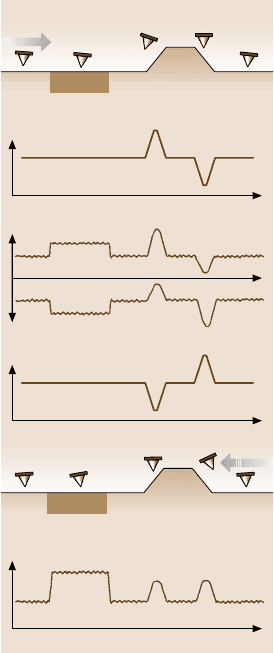
342 Bharat Bhushan
Surface slope
T
Friction force
T
R
Surface slope
R
Friction force
T-R
B
A
T
μ
2
> μ
1
R
μ
1
Fig. 8.20. Schematic of friction forces expected
when a tip traverses a sample that is composed of
different materials and sharp changes in topogra-
phy. A schematic of surface slope is also shown
effect on the directionality effect of friction. We will note later that the magnitude of
the surface slopes are virtually identical, therefore, the tip shape asymmetry should
not have much effect.
Figure 8.21 shows surface height and friction force data for a gold ruler and
a silicon grid in the trace and retrace directions. Subtraction of the two friction data
yields a residual peak because of the differences in the magnitudes of the friction
forces in the two directions. This effect is observed at all locations where there is
significant change in topography.
In order to facilitate comparison of the effect of directionality on friction, it is
important to take into account the change of sign of the surface slope and friction
force in the trace and retrace directions. Figure 8.22 shows surface height, surface
slope, and friction force data for the two samples in the trace and retrace direc-
tions. The correlations between surface slope and friction forces are clear. The third
column in the figures shows the retrace slope and friction data with an inverted
sign (−retrace). Now we can compare the trace data with the −retrace data. It is
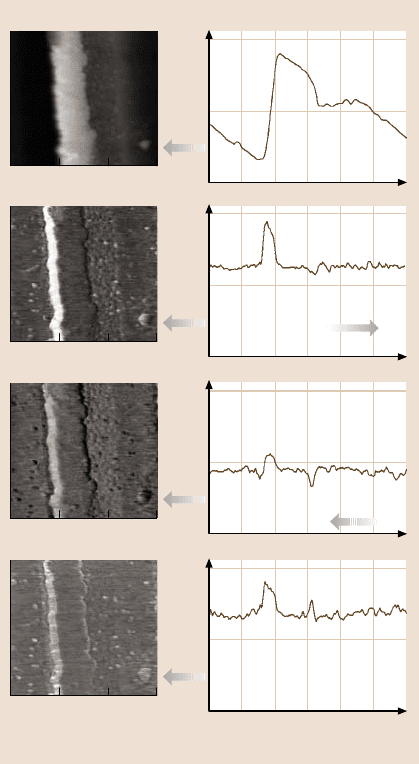
8 Nanotribology, Nanomechanics and Materials Characterization 343
50
0 nm
–50
0.35
0 V
–0.35
0.35
0 V
–0.35
0
0.35
0 V
–0.35
0 1.50
μm
0.75 1.50
Surface
height
Friction
force (T)
Friction
force (R)
Friction
force (T-R)
a)
A
B
Scan distance (μm)
Fig. 8.21. (a) Greyscale
images and two-dimensional
profiles of surface height and
friction forces across a single
ruling of the gold-coated
ruling
clear that the friction experienced by the tip is dependent upon the scanning direc-
tion because of the surface topography. In addition to the effect of topographical
changes discussed earlier, during surface-finishing processes material can be trans-
ferred preferentially onto one side of the asperities, which also causes asymmetry
and direction dependence. Reduction in local variations and in the directionality of
friction properties requires careful optimization of surface-roughness distributions
and of surface-finishing processes.
The directionality as a result of the surface asperities effect will also manifest
itself in macroscopic friction data, i.e., the coefficient of friction may be different
in one sliding direction than that in the other direction. Asymmetrical shape of as-
perities accentuates this effect. Frictional directionality can also exist in materials
